1997 SSANGYONG KORANDO fuse
[x] Cancel search: fusePage 1632 of 2053
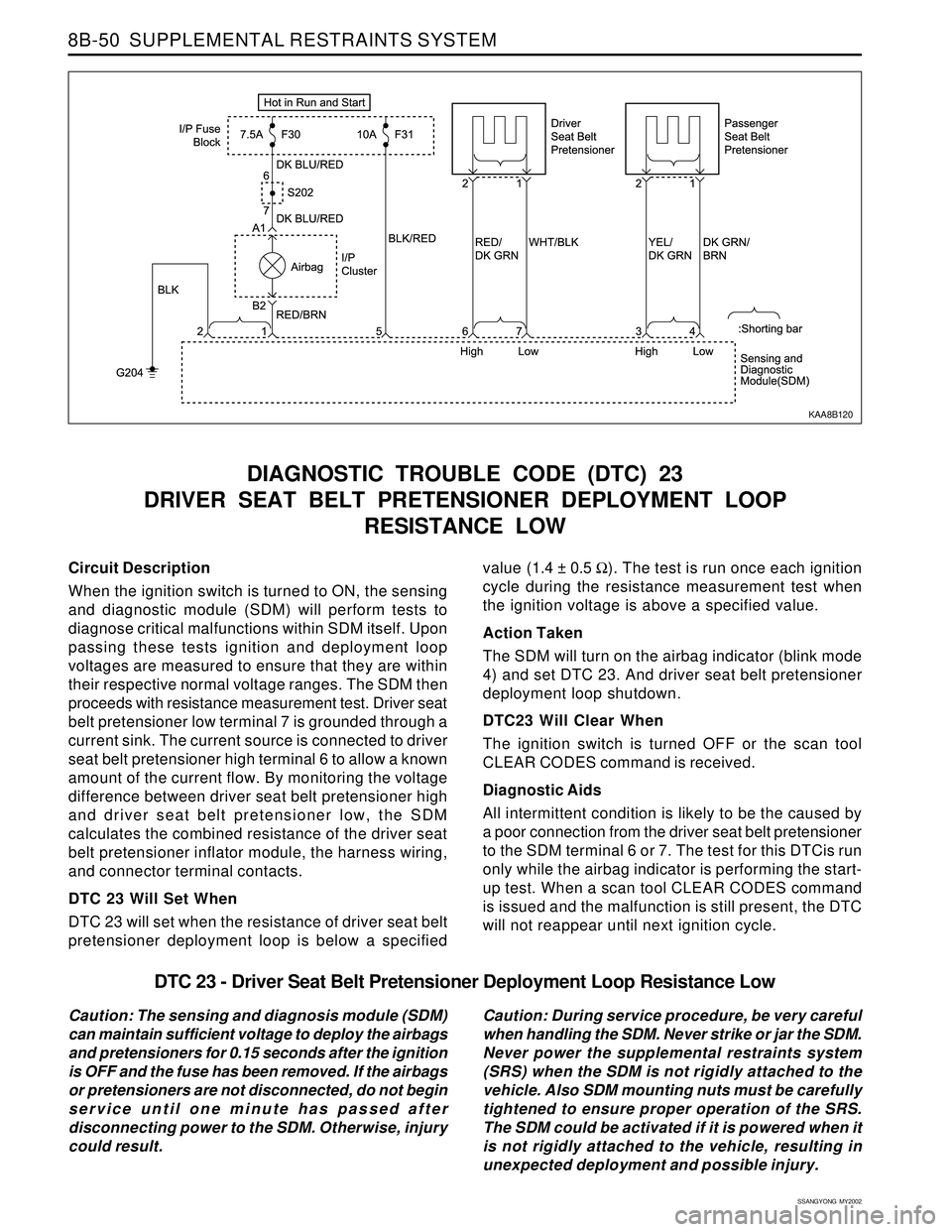
SSANGYONG MY2002
8B-50 SUPPLEMENTAL RESTRAINTS SYSTEM
Circuit Description
When the ignition switch is turned to ON, the sensing
and diagnostic module (SDM) will perform tests to
diagnose critical malfunctions within SDM itself. Upon
passing these tests ignition and deployment loop
voltages are measured to ensure that they are within
their respective normal voltage ranges. The SDM then
proceeds with resistance measurement test. Driver seat
belt pretensioner low terminal 7 is grounded through a
current sink. The current source is connected to driver
seat belt pretensioner high terminal 6 to allow a known
amount of the current flow. By monitoring the voltage
difference between driver seat belt pretensioner high
and driver seat belt pretensioner low, the SDM
calculates the combined resistance of the driver seat
belt pretensioner inflator module, the harness wiring,
and connector terminal contacts.
DTC 23 Will Set When
DTC 23 will set when the resistance of driver seat belt
pretensioner deployment loop is below a specified
DIAGNOSTIC TROUBLE CODE (DTC) 23
DRIVER SEAT BELT PRETENSIONER DEPLOYMENT LOOP
RESISTANCE LOW
value (1.4 ± 0.5 Ω). The test is run once each ignition
cycle during the resistance measurement test when
the ignition voltage is above a specified value.
Action Taken
The SDM will turn on the airbag indicator (blink mode
4) and set DTC 23. And driver seat belt pretensioner
deployment loop shutdown.
DTC23 Will Clear When
The ignition switch is turned OFF or the scan tool
CLEAR CODES command is received.
Diagnostic Aids
All intermittent condition is likely to be the caused by
a poor connection from the driver seat belt pretensioner
to the SDM terminal 6 or 7. The test for this DTCis run
only while the airbag indicator is performing the start-
up test. When a scan tool CLEAR CODES command
is issued and the malfunction is still present, the DTC
will not reappear until next ignition cycle.
KAA8B120
DTC 23 - Driver Seat Belt Pretensioner Deployment Loop Resistance Low
Caution: The sensing and diagnosis module (SDM)
can maintain sufficient voltage to deploy the airbags
and pretensioners for 0.15 seconds after the ignition
is OFF and the fuse has been removed. If the airbags
or pretensioners are not disconnected, do not begin
service until one minute has passed after
disconnecting power to the SDM. Otherwise, injury
could result.Caution: During service procedure, be very careful
when handling the SDM. Never strike or jar the SDM.
Never power the supplemental restraints system
(SRS) when the SDM is not rigidly attached to the
vehicle. Also SDM mounting nuts must be carefully
tightened to ensure proper operation of the SRS.
The SDM could be activated if it is powered when it
is not rigidly attached to the vehicle, resulting in
unexpected deployment and possible injury.
Page 1634 of 2053
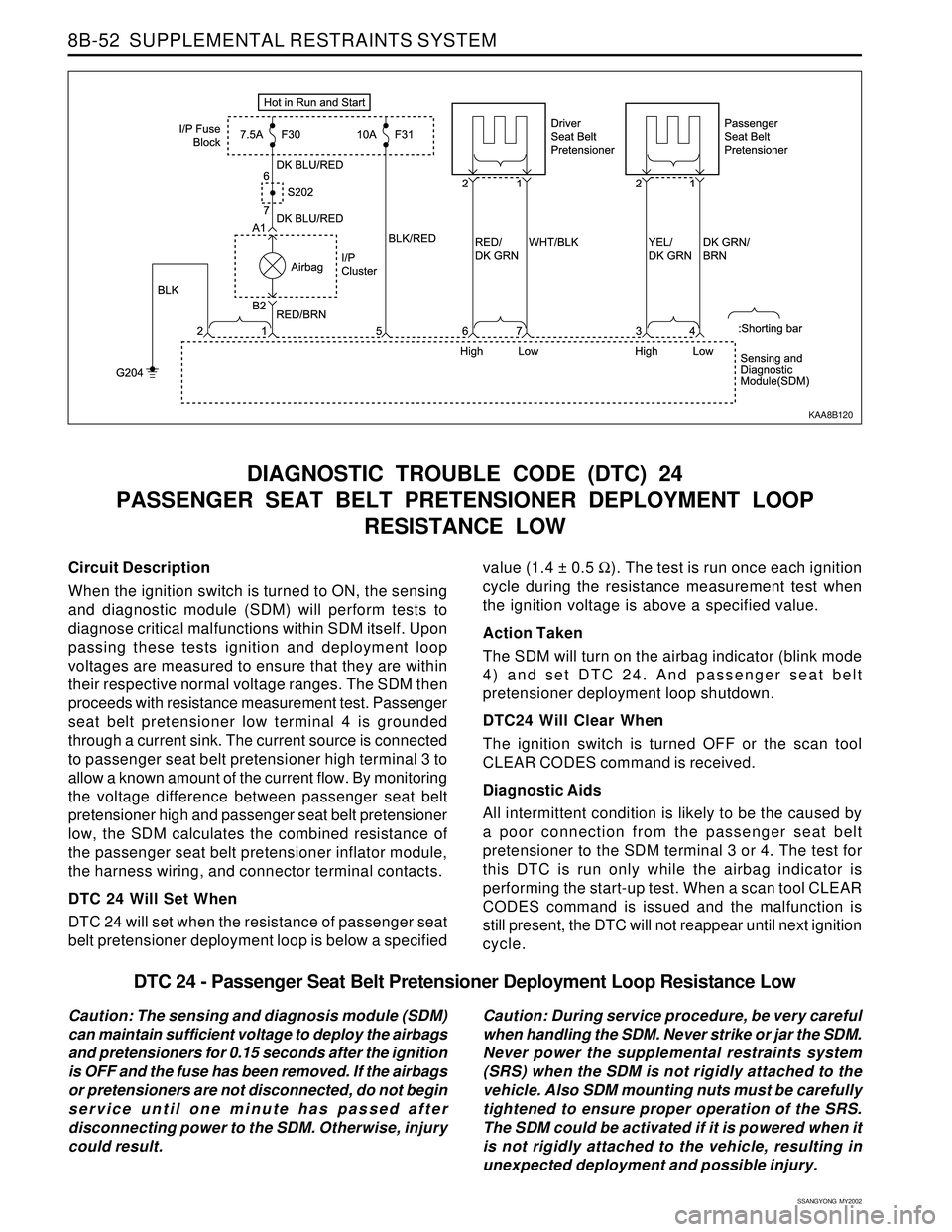
SSANGYONG MY2002
8B-52 SUPPLEMENTAL RESTRAINTS SYSTEM
Circuit Description
When the ignition switch is turned to ON, the sensing
and diagnostic module (SDM) will perform tests to
diagnose critical malfunctions within SDM itself. Upon
passing these tests ignition and deployment loop
voltages are measured to ensure that they are within
their respective normal voltage ranges. The SDM then
proceeds with resistance measurement test. Passenger
seat belt pretensioner low terminal 4 is grounded
through a current sink. The current source is connected
to passenger seat belt pretensioner high terminal 3 to
allow a known amount of the current flow. By monitoring
the voltage difference between passenger seat belt
pretensioner high and passenger seat belt pretensioner
low, the SDM calculates the combined resistance of
the passenger seat belt pretensioner inflator module,
the harness wiring, and connector terminal contacts.
DTC 24 Will Set When
DTC 24 will set when the resistance of passenger seat
belt pretensioner deployment loop is below a specified
DIAGNOSTIC TROUBLE CODE (DTC) 24
PASSENGER SEAT BELT PRETENSIONER DEPLOYMENT LOOP
RESISTANCE LOW
value (1.4 ± 0.5 Ω). The test is run once each ignition
cycle during the resistance measurement test when
the ignition voltage is above a specified value.
Action Taken
The SDM will turn on the airbag indicator (blink mode
4) and set DTC 24. And passenger seat belt
pretensioner deployment loop shutdown.
DTC24 Will Clear When
The ignition switch is turned OFF or the scan tool
CLEAR CODES command is received.
Diagnostic Aids
All intermittent condition is likely to be the caused by
a poor connection from the passenger seat belt
pretensioner to the SDM terminal 3 or 4. The test for
this DTC is run only while the airbag indicator is
performing the start-up test. When a scan tool CLEAR
CODES command is issued and the malfunction is
still present, the DTC will not reappear until next ignition
cycle.
KAA8B120
DTC 24 - Passenger Seat Belt Pretensioner Deployment Loop Resistance Low
Caution: The sensing and diagnosis module (SDM)
can maintain sufficient voltage to deploy the airbags
and pretensioners for 0.15 seconds after the ignition
is OFF and the fuse has been removed. If the airbags
or pretensioners are not disconnected, do not begin
service until one minute has passed after
disconnecting power to the SDM. Otherwise, injury
could result.Caution: During service procedure, be very careful
when handling the SDM. Never strike or jar the SDM.
Never power the supplemental restraints system
(SRS) when the SDM is not rigidly attached to the
vehicle. Also SDM mounting nuts must be carefully
tightened to ensure proper operation of the SRS.
The SDM could be activated if it is powered when it
is not rigidly attached to the vehicle, resulting in
unexpected deployment and possible injury.
Page 1636 of 2053
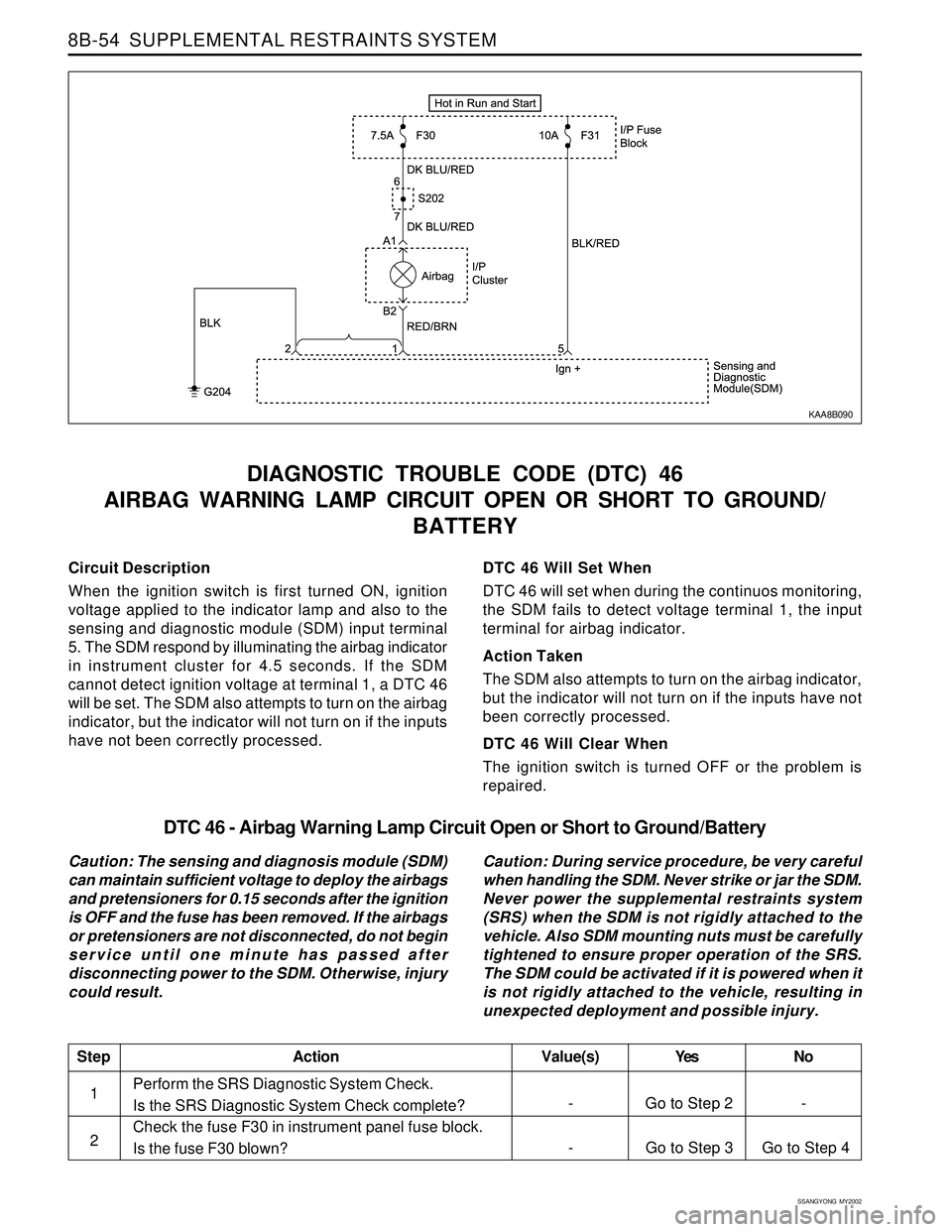
SSANGYONG MY2002
8B-54 SUPPLEMENTAL RESTRAINTS SYSTEM
Circuit Description
When the ignition switch is first turned ON, ignition
voltage applied to the indicator lamp and also to the
sensing and diagnostic module (SDM) input terminal
5. The SDM respond by illuminating the airbag indicator
in instrument cluster for 4.5 seconds. If the SDM
cannot detect ignition voltage at terminal 1, a DTC 46
will be set. The SDM also attempts to turn on the airbag
indicator, but the indicator will not turn on if the inputs
have not been correctly processed.
DIAGNOSTIC TROUBLE CODE (DTC) 46
AIRBAG WARNING LAMP CIRCUIT OPEN OR SHORT TO GROUND/
BATTERY
DTC 46 Will Set When
DTC 46 will set when during the continuos monitoring,
the SDM fails to detect voltage terminal 1, the input
terminal for airbag indicator.
Action Taken
The SDM also attempts to turn on the airbag indicator,
but the indicator will not turn on if the inputs have not
been correctly processed.
DTC 46 Will Clear When
The ignition switch is turned OFF or the problem is
repaired.
KAA8B090
DTC 46 - Airbag Warning Lamp Circuit Open or Short to Ground/Battery
Caution: The sensing and diagnosis module (SDM)
can maintain sufficient voltage to deploy the airbags
and pretensioners for 0.15 seconds after the ignition
is OFF and the fuse has been removed. If the airbags
or pretensioners are not disconnected, do not begin
service until one minute has passed after
disconnecting power to the SDM. Otherwise, injury
could result.Caution: During service procedure, be very careful
when handling the SDM. Never strike or jar the SDM.
Never power the supplemental restraints system
(SRS) when the SDM is not rigidly attached to the
vehicle. Also SDM mounting nuts must be carefully
tightened to ensure proper operation of the SRS.
The SDM could be activated if it is powered when it
is not rigidly attached to the vehicle, resulting in
unexpected deployment and possible injury.
Perform the SRS Diagnostic System Check.
Is the SRS Diagnostic System Check complete?
Check the fuse F30 in instrument panel fuse block.
Is the fuse F30 blown?
StepAction Value(s) Yes No
1
- Go to Step 3 Go to Step 4 2
- Go to Step 2 -
Page 1637 of 2053
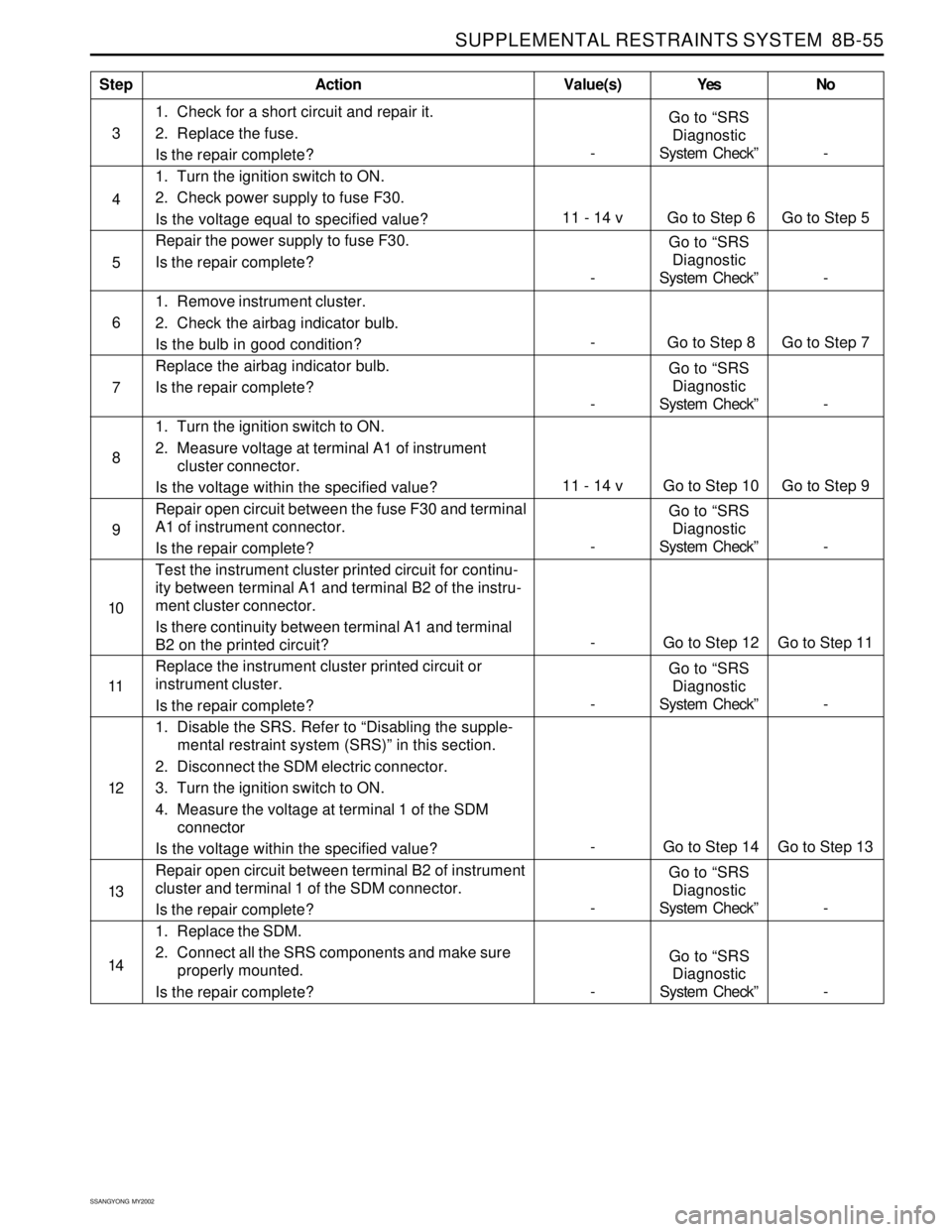
SUPPLEMENTAL RESTRAINTS SYSTEM 8B-55
SSANGYONG MY2002
1. Check for a short circuit and repair it.
2. Replace the fuse.
Is the repair complete?
1. Turn the ignition switch to ON.
2. Check power supply to fuse F30.
Is the voltage equal to specified value?
Repair the power supply to fuse F30.
Is the repair complete?
1. Remove instrument cluster.
2. Check the airbag indicator bulb.
Is the bulb in good condition?
Replace the airbag indicator bulb.
Is the repair complete?
1. Turn the ignition switch to ON.
2. Measure voltage at terminal A1 of instrument
cluster connector.
Is the voltage within the specified value?
Repair open circuit between the fuse F30 and terminal
A1 of instrument connector.
Is the repair complete?
Test the instrument cluster printed circuit for continu-
ity between terminal A1 and terminal B2 of the instru-
ment cluster connector.
Is there continuity between terminal A1 and terminal
B2 on the printed circuit?
Replace the instrument cluster printed circuit or
instrument cluster.
Is the repair complete?
1. Disable the SRS. Refer to “Disabling the supple-
mental restraint system (SRS)” in this section.
2. Disconnect the SDM electric connector.
3. Turn the ignition switch to ON.
4. Measure the voltage at terminal 1 of the SDM
connector
Is the voltage within the specified value?
Repair open circuit between terminal B2 of instrument
cluster and terminal 1 of the SDM connector.
Is the repair complete?
1. Replace the SDM.
2. Connect all the SRS components and make sure
properly mounted.
Is the repair complete?
StepAction Value(s) Yes No
4
6
7
8
11 - 14 v Go to Step 6 Go to Step 5
5
-Go to “SRS
Diagnostic
System Check” -
- Go to Step 8 Go to Step 7
-Go to “SRS
Diagnostic
System Check” -
9
10
11
12
-Go to “SRS
Diagnostic
System Check” - 3
11 - 14 v Go to Step 10 Go to Step 9
-Go to “SRS
Diagnostic
System Check” -
13
- Go to Step 12 Go to Step 11
- Go to Step 14 Go to Step 13
-Go to “SRS
Diagnostic
System Check” -
-Go to “SRS
Diagnostic
System Check” - 14
-Go to “SRS
Diagnostic
System Check” -
Page 1638 of 2053
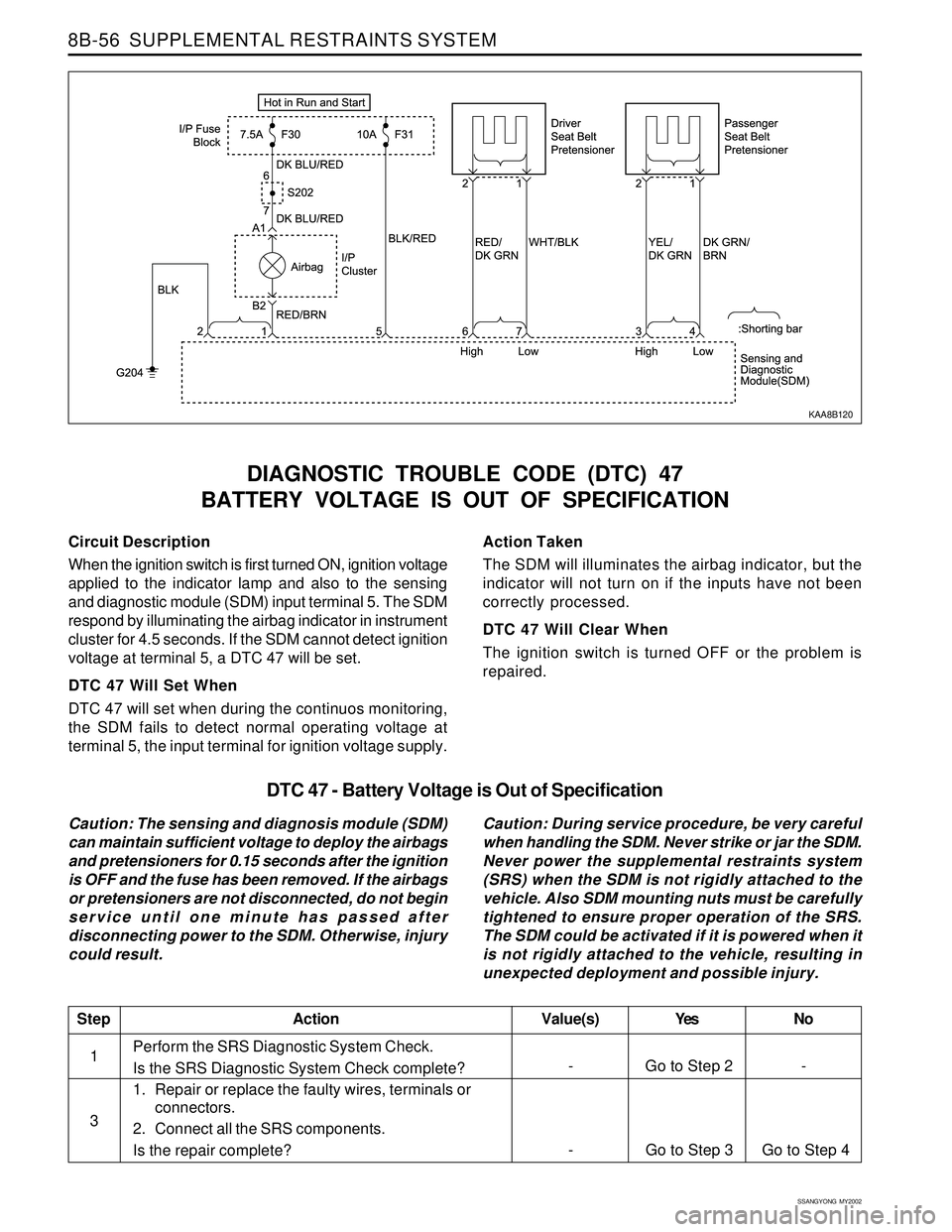
SSANGYONG MY2002
8B-56 SUPPLEMENTAL RESTRAINTS SYSTEM
Circuit Description
When the ignition switch is first turned ON, ignition voltage
applied to the indicator lamp and also to the sensing
and diagnostic module (SDM) input terminal 5. The SDM
respond by illuminating the airbag indicator in instrument
cluster for 4.5 seconds. If the SDM cannot detect ignition
voltage at terminal 5, a DTC 47 will be set.
DTC 47 Will Set When
DTC 47 will set when during the continuos monitoring,
the SDM fails to detect normal operating voltage at
terminal 5, the input terminal for ignition voltage supply.
DIAGNOSTIC TROUBLE CODE (DTC) 47
BATTERY VOLTAGE IS OUT OF SPECIFICATION
Action Taken
The SDM will illuminates the airbag indicator, but the
indicator will not turn on if the inputs have not been
correctly processed.
DTC 47 Will Clear When
The ignition switch is turned OFF or the problem is
repaired.
KAA8B120
DTC 47 - Battery Voltage is Out of Specification
Caution: The sensing and diagnosis module (SDM)
can maintain sufficient voltage to deploy the airbags
and pretensioners for 0.15 seconds after the ignition
is OFF and the fuse has been removed. If the airbags
or pretensioners are not disconnected, do not begin
service until one minute has passed after
disconnecting power to the SDM. Otherwise, injury
could result.Caution: During service procedure, be very careful
when handling the SDM. Never strike or jar the SDM.
Never power the supplemental restraints system
(SRS) when the SDM is not rigidly attached to the
vehicle. Also SDM mounting nuts must be carefully
tightened to ensure proper operation of the SRS.
The SDM could be activated if it is powered when it
is not rigidly attached to the vehicle, resulting in
unexpected deployment and possible injury.
Perform the SRS Diagnostic System Check.
Is the SRS Diagnostic System Check complete?
1. Repair or replace the faulty wires, terminals or
connectors.
2. Connect all the SRS components.
Is the repair complete?
StepAction Value(s) Yes No
1
-
Go to Step 3 Go to Step 4 3
- Go to Step 2 -
Page 1639 of 2053
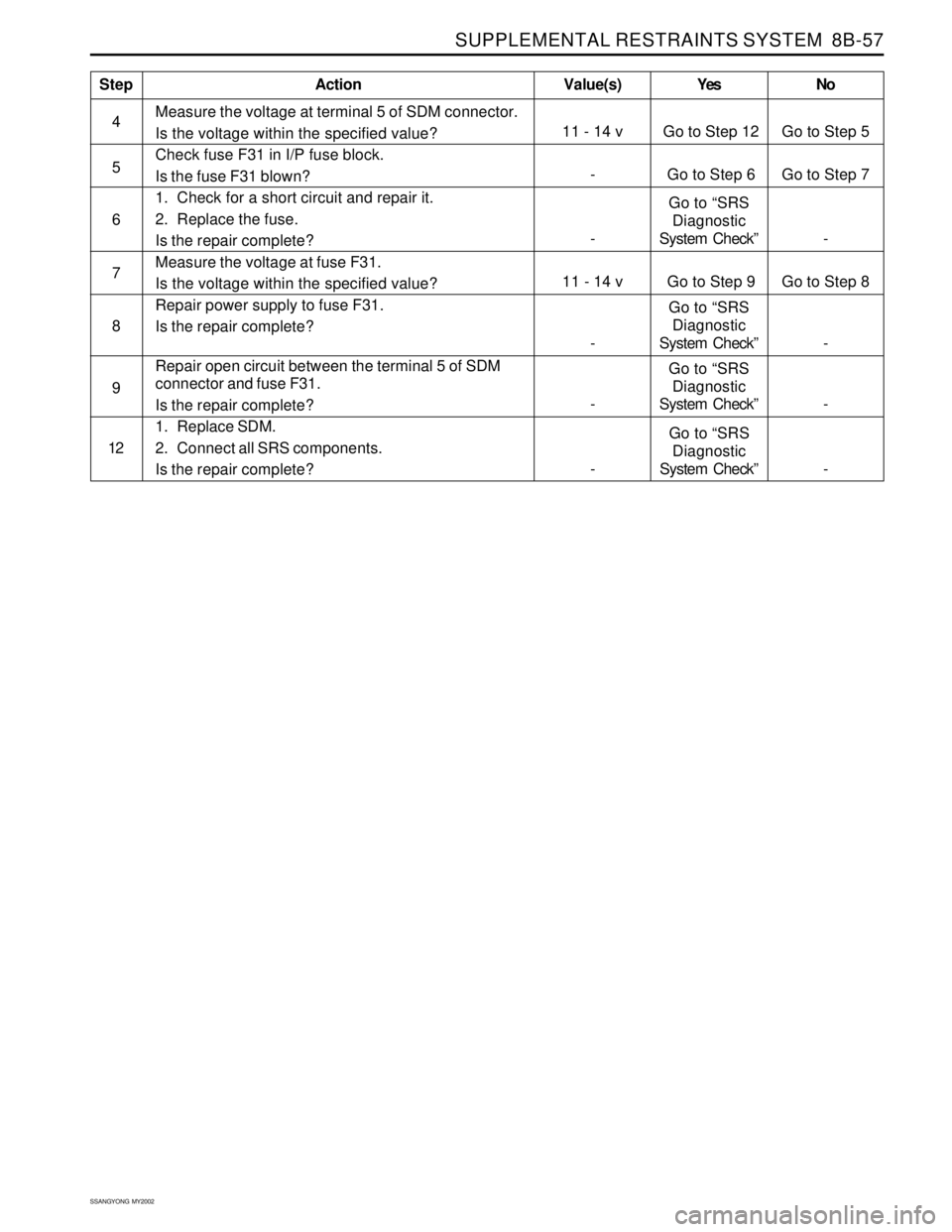
SUPPLEMENTAL RESTRAINTS SYSTEM 8B-57
SSANGYONG MY2002
Measure the voltage at terminal 5 of SDM connector.
Is the voltage within the specified value?
Check fuse F31 in I/P fuse block.
Is the fuse F31 blown?
1. Check for a short circuit and repair it.
2. Replace the fuse.
Is the repair complete?
Measure the voltage at fuse F31.
Is the voltage within the specified value?
Repair power supply to fuse F31.
Is the repair complete?
Repair open circuit between the terminal 5 of SDM
connector and fuse F31.
Is the repair complete?
1. Replace SDM.
2. Connect all SRS components.
Is the repair complete?
StepAction Value(s) Yes No
4
6
7
811 - 14 v Go to Step 12 Go to Step 5
5
-Go to “SRS
Diagnostic
System Check” -
- Go to Step 6 Go to Step 7
-Go to “SRS
Diagnostic
System Check” -
9
12
-Go to “SRS
Diagnostic
System Check” -
11 - 14 v Go to Step 9 Go to Step 8
-Go to “SRS
Diagnostic
System Check” -
Page 1640 of 2053
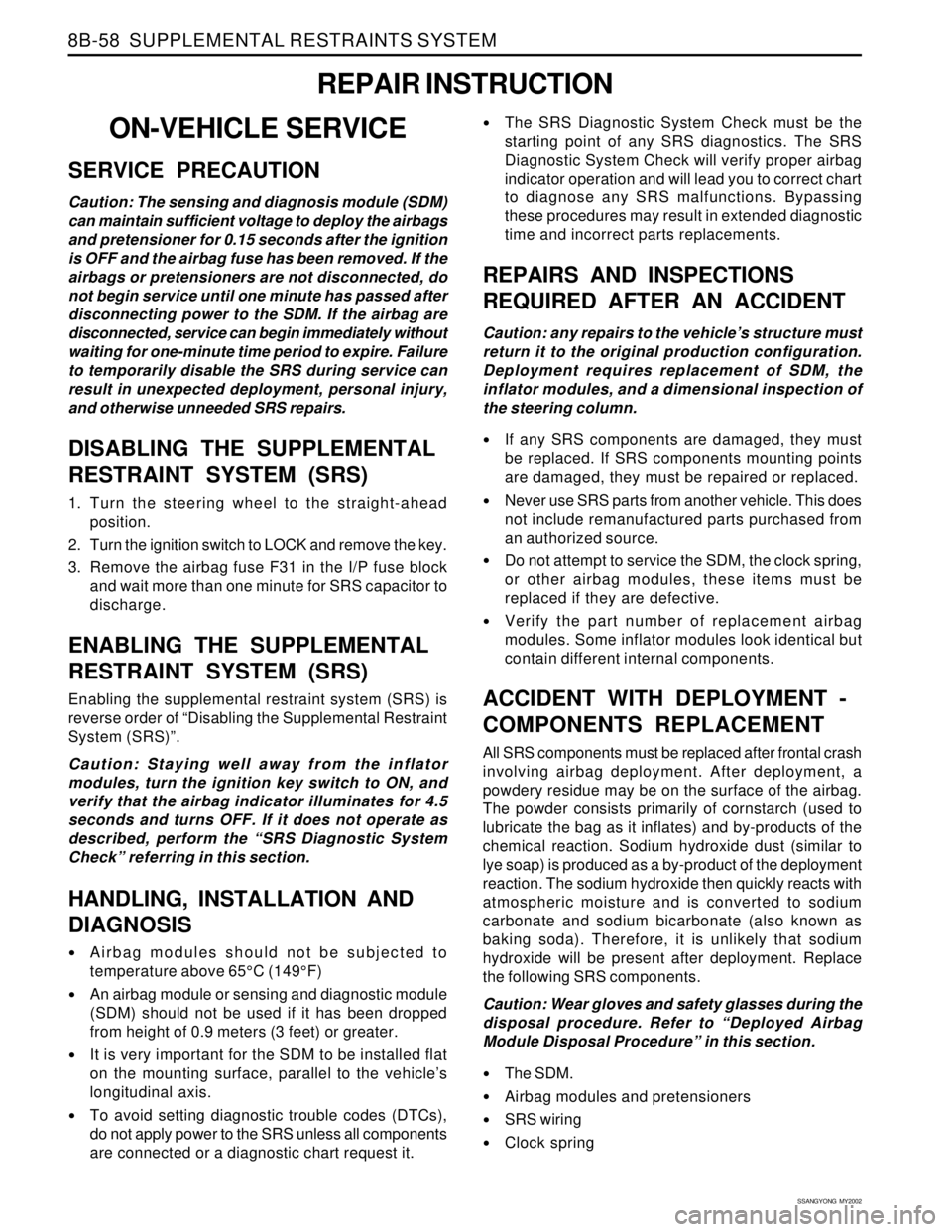
SSANGYONG MY2002
8B-58 SUPPLEMENTAL RESTRAINTS SYSTEM
REPAIR INSTRUCTION
ON-VEHICLE SERVICE
SERVICE PRECAUTION
Caution: The sensing and diagnosis module (SDM)
can maintain sufficient voltage to deploy the airbags
and pretensioner for 0.15 seconds after the ignition
is OFF and the airbag fuse has been removed. If the
airbags or pretensioners are not disconnected, do
not begin service until one minute has passed after
disconnecting power to the SDM. If the airbag are
disconnected, service can begin immediately without
waiting for one-minute time period to expire. Failure
to temporarily disable the SRS during service can
result in unexpected deployment, personal injury,
and otherwise unneeded SRS repairs.
DISABLING THE SUPPLEMENTAL
RESTRAINT SYSTEM (SRS)
1. Turn the steering wheel to the straight-ahead
position.
2. Turn the ignition switch to LOCK and remove the key.
3. Remove the airbag fuse F31 in the I/P fuse block
and wait more than one minute for SRS capacitor to
discharge.
ENABLING THE SUPPLEMENTAL
RESTRAINT SYSTEM (SRS)
Enabling the supplemental restraint system (SRS) is
reverse order of “Disabling the Supplemental Restraint
System (SRS)”.
Caution: Staying well away from the inflator
modules, turn the ignition key switch to ON, and
verify that the airbag indicator illuminates for 4.5
seconds and turns OFF. If it does not operate as
described, perform the “SRS Diagnostic System
Check” referring in this section.
HANDLING, INSTALLATION AND
DIAGNOSIS
Airbag modules should not be subjected to
temperature above 65°C (149°F)
An airbag module or sensing and diagnostic module
(SDM) should not be used if it has been dropped
from height of 0.9 meters (3 feet) or greater.
It is very important for the SDM to be installed flat
on the mounting surface, parallel to the vehicle’s
longitudinal axis.
To avoid setting diagnostic trouble codes (DTCs),
do not apply power to the SRS unless all components
are connected or a diagnostic chart request it.
The SRS Diagnostic System Check must be the
starting point of any SRS diagnostics. The SRS
Diagnostic System Check will verify proper airbag
indicator operation and will lead you to correct chart
to diagnose any SRS malfunctions. Bypassing
these procedures may result in extended diagnostic
time and incorrect parts replacements.
REPAIRS AND INSPECTIONS
REQUIRED AFTER AN ACCIDENT
Caution: any repairs to the vehicle’s structure must
return it to the original production configuration.
Deployment requires replacement of SDM, the
inflator modules, and a dimensional inspection of
the steering column.
If any SRS components are damaged, they must
be replaced. If SRS components mounting points
are damaged, they must be repaired or replaced.
Never use SRS parts from another vehicle. This does
not include remanufactured parts purchased from
an authorized source.
Do not attempt to service the SDM, the clock spring,
or other airbag modules, these items must be
replaced if they are defective.
Verify the part number of replacement airbag
modules. Some inflator modules look identical but
contain different internal components.
ACCIDENT WITH DEPLOYMENT -
COMPONENTS REPLACEMENT
All SRS components must be replaced after frontal crash
involving airbag deployment. After deployment, a
powdery residue may be on the surface of the airbag.
The powder consists primarily of cornstarch (used to
lubricate the bag as it inflates) and by-products of the
chemical reaction. Sodium hydroxide dust (similar to
lye soap) is produced as a by-product of the deployment
reaction. The sodium hydroxide then quickly reacts with
atmospheric moisture and is converted to sodium
carbonate and sodium bicarbonate (also known as
baking soda). Therefore, it is unlikely that sodium
hydroxide will be present after deployment. Replace
the following SRS components.
Caution: Wear gloves and safety glasses during the
disposal procedure. Refer to “Deployed Airbag
Module Disposal Procedure” in this section.
The SDM.
Airbag modules and pretensioners
SRS wiring
Clock spring
Page 1642 of 2053

SSANGYONG MY2002
8B-60 SUPPLEMENTAL RESTRAINTS SYSTEM
KAA8B140
DRIVER AIRBAG MODULE
Removal and installation Procedure
1. Disconnect the negative battery cable.
Caution: The SDM can maintain sufficient
voltage to deploy the airbags for 0.15 seconds
after the Ignition is OFF and the airbag fuse has
been removed. If the airbags are not
disconnected, service cannot begin until one
minute has passed after disconnecting power
to the SDM. If the airbags are disconnected,
service can begin immediately without waiting
for one-minute time period to expire. Failure to
temporarily disable the SRS during service
result in unexpected deployment, personal
injury, and otherwise unneeded SRS repair.
2. Disable the supplemental restraint system (SRS).
Refer to “Disabling the SRS” in this section.
3. Position the steering wheel straight ahead.
4. Remove the driver airbag module mounting bolts.
Installation Notice
Caution: When handling an airbag module,
always keeps the top of the unit facing upward.
This leaves room for the airbag to expand if the
module unexpectedly deploys. Without room
for expansion, a module suddenly propelled
toward a person or object can cause injury or
vehicle damage.
5. Remove the connector from the horn terminal and
the driver airbag module.
6. Remove the driver airbag module.
7. Installation should follow the removal procedure
in the reverse order.
Tightening Torque 8 Nm (71 lb-in)